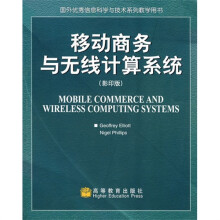Preface
Acknowledgements
1 Mobile commerce (M-commerce): definitionsand context
1.1 Defining M-commerce
1.2 A short history of wireless computing
1.2.1 First generation wireless communication
1.2.2 Second generation wireless communication
1.2.3 Third generation wireless communication
1.3 Diffusion of M-commerce innovation
1.4 Obstacles to M-commerce
1.5 The Mobile Internet and mobile information assets
1.6 The untethered Mobile Internet
1.7 M-commerce versus E-commerce
1.8 The wireless world
1.9 Pervasive computing systems, theory and practice
1.10 Trends in mobile and pervasive computing
1.11 Applications of M-commerce
1.12 The trend towards mobile working
1.12.1 Wireless telemetry and wireless telematics
1.12.2 Tracking and monitoring hte modile wordforce
1.12.3 Customer-focused products and services
1.13 Effectiveness and efficiency in mobile domains
1.14 The M-commerce value chain
1.15 Networked wireless business systems
1.16 Bluetooth technology
1.17 Factors determining M-commerce innovation and adoption in the 21st century
1.17.1 Five characteristics of innovation
1.17.2 The socio-technical perspective of technology innovation and adoption
1.18 Conclusions
Short self-assessment questions and Group activity
References and Bibliography
2 Commercial communications and networks
2.1 Introduction
2.2 The nature of commercial communication
2.3 Communication and language complexity
2.4 Information and meaning
2.4.1 Information as channel capacity
2.4.2 Information as a measure of variety
2.4.3 Information as a means of reducing uncertainty
2.4.4 Information as a measure of an agent's ability to estimate a parameter
2.5 Data and knowledge
2.6 Shared meaning
2.7 Communication and information theory
2.7.1 Source
2.7.2 Transmitter
2.7.3 Channel
2.7.4 Noise
2.7.5 Receiver
2.7.6 Destination
2.7.7 Channels and transportation
2.8 Telecommunications and networks
2.9 Media types in telecommunications
2.9.1 Bound media
2.9.2 Unbound media
2.10 Modulation and digitization
2.10.1 Modulation
2.10.2 Digitization
2.11 Communication network infrastructures
2.12 Types of channel
2.12.1 Circuit switching
2.12.2 Packet switching
2.12.3 Protocols and protocol stacks
2.13 The International Standards Organization reference Model
2.13.1 Application Layer
2.13.2 Presentation Layer
2.13.3 Session Layer
2.13.4 Transport Layer
2.13.5 Network Layer
2.13.6 Data Link Layer
2.13.7 Physical Layer
2.14 Transport Control Protocol/Internet Protocol (TCP/IP)
……
3. Wireless protocols: context and usage
4. Wireless programming for mobile devices: context and usage
5. Operating systems: micro and macro devices
6. Personal area and mobile networking
7. Wireless applications: push and pull services and products
8. Pervasive and embedded mobile systems
9. Security in a mobile world
10. Enabling the mobile workforce: extending enterpri

 缺书网
缺书网 扫码进群
扫码进群



